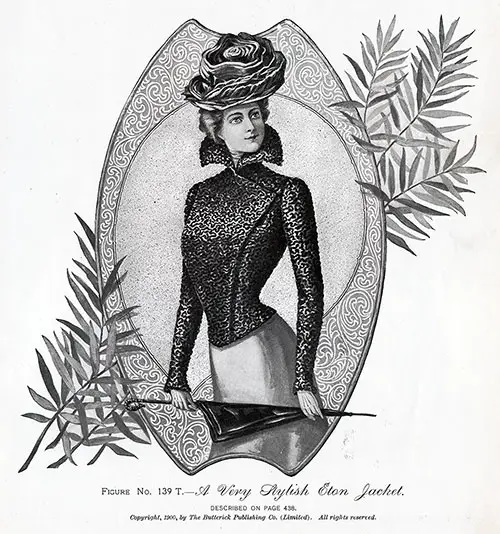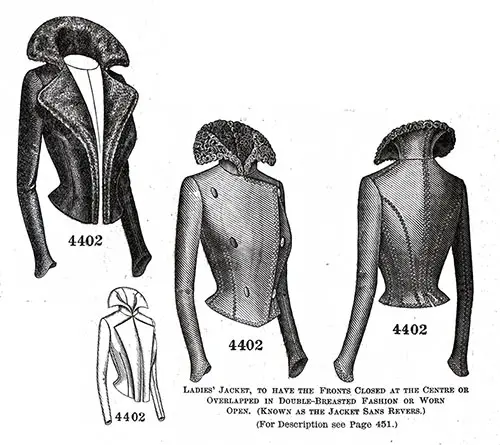Ladies Very Stylish Eton Jacket 139 T - 1900

Ladies' Very Stylish Eton Jacket No. 139 T
A Very Stylish Ladies' Eton Jacket is a classic, short jacket originally, typically black in color, worn at Eton College. This vintage design dates from 1900.
The woman with forethought will not allow the cold weather to find her without a comfortable top garment.
The design illustrated here, developed in Persian lamb, is a new and especially attractive mode known as the Jacket Sans Revers.
It is carefully adjusted at the back and sides, the center seam terminating above the lower edge to form a vent.
The semi-fitted fronts are broadly lapped and closed diagonally and deepen to give the long-waisted effect now so desirable. The close-fitting sleeves, with a bell at the wrist, and high flare collar contribute to the authentic style of the garment.
Dressmaker Options
Melton. Kersey, broadcloth diagonal, serge, Cheviot, etc., will develop pleasingly by the mode, with machine-stitching for the finish.
If desired, the fronts may be worn open and with the collar faced with satin or panne velvet. A handsome jacket could be of black velvet with chinchilla for the inside of the collar.
Pattern Information
The pattern, which is No. 4402 and costs 10d. or 20 cents, is in nine sizes for ladies from thirty to forty-six inches, bust Measure, and is pictured differently on page 443.
Ladies’ Jacket 4402

Illustrations on Page 443 | Described on Page 451
Different developments of this sporty jacket are shown in figures Nos. 139T and 158 T in this magazine.
Description
The extended effect from shoulder to bust—a prominent feature of the newest jackets—emphasizes the natty top garment here shown made of satin-faced cloth with Persian lamb and in dark velvet combined with chinchilla fur.
The mode is known as the "Jacket Sans Revers" and reaches to a short distance below the line of the waist; it is adjusted snugly at the back and sides by the regulation seams and gores, the center back seam ending to form a vent.
The fronts have the slightest suggestion of a point at the lower edge and are semi-tight fitting; they may be lapped to the throat and closed in double-breasted style or be worn open and rolled as shown in one of the large front views or closed only at the throat and rolled as shown in the small illustration.
A high, sectional collar flared at the throat gives a becoming touch to the mode, and the closely adjusted sleeves may bell over the hand or be straight-around.
Dressmaker Options
Broadcloth, covert, Venetian, and all suitable tailored fabric may be used in the reproduction of the jacket, with fur for the collar and for facing the fronts.
Hunter's green cloth combined with mink would develop a very stylish and serviceable jacket, and the closing could be done with cord loops and olives.
An attractive jacket could be made of dark-brown or black light-weight Melton, and the finish may be plain, or braid or narrow fur bindings may be added.
Pattern Information
We have pattern No. 4402 in nine sizes for ladies from thirty to forty-six inches, bust measure.
To make the jacket for a lady of medium size needs a yard and five-eighths of material fifty-four inches wide:
Price of pattern, 10d. or 20 cents.
"Descriptions of Figures in Colors, Tints, Etc., Shown on First Page of Cover and Pages 423 to 437 Inclusive," in The Delineator: An Illustrated Magazine of Literature and Fashion, Paris-London-New York: The Butterick Publishing Co. Ltd., Vol. LVI, No. 4, October 1900, p. 423, 438, 443, 451.
Editor's Note: Some terminology used in the description of women's clothing during the 1800s and early 1900s has been changed to reflect more modern terms. For example, a women's "Toilette" -- a form of costume or outfit has an entirely different common meaning in the 21st century. Typical terms applied to "toilette" include outfit, ensemble, or costume, depending on context.
Note: We have edited this text to correct grammatical errors and improve word choice to clarify the article for today’s readers. Changes made are typically minor, and we often left passive text “as is.” Those who need to quote the article directly should verify any changes by reviewing the original material.
Vintage Outerwear Fashions
GG Archives
Vintage Outerwear Fashions
- Ladies Outdoor Garment 351 L - 1890
- Ladies Attractive Coat and Skirt 4497 4487 - 1900
- Ladies Outdoor Dress and Long Coat 140 T & 141 T - 1900
- Ladies Very Stylish Eton Jacket 139 T - 1900
- Ladies Afternoon Two-Piece Outfit 208 T - 1900
- Ladies Attractive Calling Outfits 184 T and 185 T - 1900
- Ladies Fashionable Street Outfits 194 T and 195 T - 1900
- Ladies Stylish Outdoor Outfits 192 T & 193 T - 1900
- Ladies Two-Piece Costumes for Rainy Days 198 T and 199 T - 1900
- Ladies and Teens Short & Long Coats No. 7410 & 7383 - 1904
- Ladies Coats and Wraps - 7418 & 7427 - 1904
- Paris Couturiers Have Introduced New Wrap Silhouette - 1919
- Resurgence of Fur Coats and Capes Seen 1922
- Rising Prestige of Knitted Outerwear March 1922
- Supple Silhouette of Fall Outerwear 1922
Vintage Fashion Topics
Updates and Social Media
- Visit our GG Archives Vintage Fashions Facebook Page for the Latest News About the Activities of the Archives.
